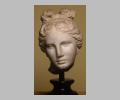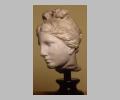| Collection: | Museum of Fine Arts, Boston |
| Title: | The Bartlett Head |
| Context: | From Athens |
| Findspot: | Found at Athens, in the area leading from Monastiraki and the Agora toward the Roman Agora |
| Summary: | Head of a female goddess, perhaps Aphrodite |
| Object Function: | Unknown |
| Sculptor: | In the style of Praxiteles |
| Material: | Marble |
| Sculpture Type: | Free-standing statue |
| Category: | Single sculpture |
| Style: | Late Classical |
| Technique: | In-the-round |
| Original or Copy: | Original |
| Date: | ca. 330 BC |
| Dimensions: | H. 0.288 m; H. of face 0.162 m |
| Scale: | Life-size |
| Region: | Attica |
| Period: | Late Classical |
Subject Description: This goddess, perhaps Aphrodite, turns her head down to her lower right, as is indicated by the curve of the neck. This tilt, as well as the softness of the carving on the skin and the heavy lids, impart a certain gentle nature to the goddess, so that conoisseurs have been inclined to interpret her as Aphrodite, the goddess of love and beauty. Her long, wavy hair is bound in a thin taenia (ribbon) that is wrapped twice around her head, and pulled back into a bun at the nape of the neck. Some locks are pulled up in loops at the top of her head, an effect that appears as a topknot, and has been referred to as lampadion ("little-torch").
Form & Style: The intense expresion, prominent brow, and parted lips are aspects of the style that are thought to have been influenced by that of Praxiteles.
Date Description: As this head reflects the style and technique of Praxiteles, it might then have been carved by a younger contemporary under his influence.
Condition: Head only (complete)
Condition Description: Small chips missing from the tip of the nose and the chin. Surface well preserved.
Material Description: "Parian" (Comstock & Vermeule)
Technique Description: This head was carved separately for insertion, as evidenced by the carving on the neck.
Collection History: Formerly in the collection of Mr. Pallis; later E.P. Warren Collection. Acquired by the MFA in 1903.
Sources Used:
Other Bibliography: A. Ajootian in The Art Museums of New England (Boston 1982) 158, fig. 59l;





